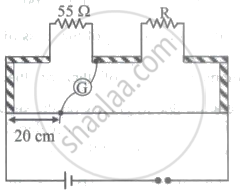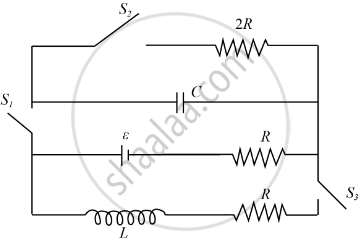Advertisements
Advertisements
Question
AB is a coil of copper wire having a large number of turns. The ends of the coil are connected with a galvanometer as shown. When the north pole of a strong bar magnet is moved towards end B of the coil, a deflection is observed in the galvanometer.

- State the reason for using galvanometer in the activity and why does its needle deflects momentarily when magnet is moved towards the coil.
- What would be observed in the galvanometer in a situation when the coil and the bar magnet both move with the same speed in the same direction? Justify your answer.
- State the conclusion that can be drawn from this activity.
Will there be any change in the momentary deflection in the galvanometer if number of turns in the coil is increased and a more stronger magnet is moved towards the coil?
OR
What is electromagnetic induction? What is observed in the galvanometer when a strong bar magnet is held stationary near one end of a coil of large number of turns? Justify your answer.
Solution
- A galvanometer is a device that detects the existence of electricity in a circuit. It deflects to the left or right of the zero mark depending on the direction of the stream.
The magnetic field associated with the coil grows as a bar magnet is pulled near it. As a result, the coil generates induced current e.m.f. As a result, the galvanometer deflects to the right. - There is no induced current when the coil and a magnet are moved in the same direction and at the same speed because there is no change in the magnetic field across the coil.
- These facts lead us to the conclusion that if the electric current through coil 1 changes, a potential difference is produced in coil 2. (starting or stopping). The primary coil is coil 1, and the secondary coil is coil 2. The magnetic field connected to the first coil varies as the current in it does. Thus, the secondary coil's magnetic field lines likewise alter. Therefore, the secondary coil's induced electric current is brought on by a change in the magnetic field lines connected to it.
Electromagnetic induction is the mechanism by which a fluctuating magnetic field in one conductor causes a current to flow through a different conductor.
The intensity of the magnetic field may be increased by turning the coil around more frequently and by employing a powerful magnet.
OR
The process, by which a changing magnetic field in a conductor induces a current in another conductor, is called electromagnetic induction.
The magnetic field across the coil does not vary if the bar magnet is kept fixed inside of it, there is no induced current in the coil. Galvanometer therefore does not display any deflection.
APPEARS IN
RELATED QUESTIONS
State the factors on which the strength of an electromagnet depends. How does it depend on these factors?
Describe one experiment to demonstrate the phenomenon of electromagnetic induction.
State the purpose of soft iron core used in making an electromagnet.
List two ways of increasing the strength of an electromagnet if the material of the electromagnet is fixed.
The diagram shows a rectangular coil ABCD, suspended freely between the concave pole pieces of a permanent horseshoe magnet, such that the plane of the coil is parallel to the magnetic field.

(i) State your observation, when current is switched on.
(ii) Give an explanation for your observation in (i).
(iii) State the rule, which will help you to find the motion of rotation of coil.
(iv) In which position will the coil ultimately come to rest?
(v) State four ways of increasing the magnitude of force acting on the coil.
The magnetic flux passing through a coil perpendicular to its plane is a function of time and is given by OB = (2t3 + 4t2 + 8t + 8) Wb. If the resistance of the coil is 5 Ω, determine the induced current through the coil at a time t = 3 second.
Shown in the figure below is a metre bridge set up with null deflection in the galvanometer. The value of the unknown resistance R is ______

In the given circuit, initially switch S1 is closed and S2 and S3 are open. After charging of capacitor, at t = 0, S1 is open and S2 and S3 are closed. If the relation between inductance capacitance and resistance is L = 4CR2 then the time (in sec) after which current passing through capacitor and inductor will be same is ______ × 10-4 N. (Given R = ℓn(2)mΩ, L = 2mH)

Show that for a given positive ion species in a cyclotron, (i) the radius of their circular path inside a dee is directly proportional to their speed, and (ii) the maximum ion energy achievable is directly proportional to the square of the magnetic induction.
